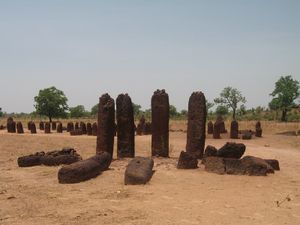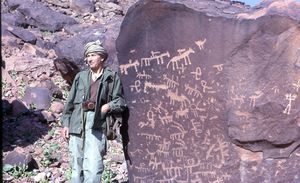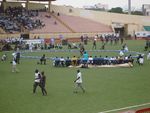سيرير (شعب)
  | |
| إجمالي التعداد | |
|---|---|
| ما يزيد على 1.8 مليون[1] | |
| المناطق ذات التجمعات المعتبرة | |
| 1.84 مليون | |
| 53,567[2] | |
| 3,500 | |
| اللغات | |
| سيرير، لغات تشانگين، ولوف، الفرنسية (السنغال وموريتانيا)، الإنگليزية (گامبيا) | |
| الدين | |
| السنغال 2002: 90% إسلام, 9% مسيحية[3] و ديانة السرر (تات روگ) | |
| الجماعات العرقية ذات الصلة | |
| ولوف، جولا وToucouleur people، و لـِبو | |
شعب السيرير Serer هم جماعة عرقية دينية في غرب أفريقيا.[4][5] وهم ثالث أكبر جماعة عرقية في السنغال، إذ يشكلون 15% من تعداد السنغال.[6] كما يوجدوا في شمال گامبيا وجنوب موريتانيا.[7]
ينحدر شعب السرر من وادي نهر السنغال على حدود السنغال وموريتانيا، ثم انتقلوا جنوباً في القرنين 11 و 12، ثم انتقلوا مرة أخرى في القرنين 15 و 16 حين غـُزِيَت قراهم وتعرضوا للاضطهاد الديني.[8][9][10] They have had a sedentary settled culture and have been known for their farming expertise and transhumant stock-raising.[9][11]
The Serer people have been historically noted as a matrilineal ethnic group that long resisted the expansion of Islam, fought against jihads in the 19th century, then opposed the French colonial rule.[12][13][14] In the 20th century, most of them converted to Islam (Sufism[15]), but some are Christians or follow their traditional religion.[12] The Serer society, like other ethnic groups in Senegal, has had social stratification featuring endogamous castes and slaves.[16][17][18]
شعب السرر يشار إليه أيضاً بالأسماء التالية: سيرر Sérère ؛ سرير Sereer؛ سـِرَّر Serrere؛ سرر Serere؛ سارر Sarer؛ كـِگـِمى Kegueme؛ سيرير Seereer وأحياناً بالخطأ "سـِرّ Serre".
الديمغرافيا والتوزع
The Serer people are primarily found in contemporary Senegal, particularly in the west-central part of the country, running from the southern edge of Dakar to the Gambian border. In The Gambia, they occupy parts of old "Nuimi" and "Baddibu" as well as the Gambian "Kombo". The Serer-Noon occupy the ancient area of Thiès in modern-day Senegal. The Serer-Ndut are found in southern Cayor and north west of ancient Thiès. The Serer-Njeghen occupy old Baol; the Serer-Palor occupies the west central, west southwest of Thiès and the Serer-Laalaa occupy west central, north of Thiès and the Tambacounda area.[19][20]
The Serer people are diverse and though they spread throughout the Senegambia region, they are more numerous in places like old Baol, Sine, Saloum and in The Gambia, which was a colony of the Kingdom of Saloum.
- السنغال: 1.84 مليون (15% من إجمالي السكان)[1]
- گامبيا: 53,567 (3.1% من الإجمالي)[2]
- Mauritania: 3,500[21]
السرر (ويُعرفون أيضاً بإسم "Seex" أو "سين-سين") يحتلون مناطق سين و سالوم (اللتين هما اليوم جزء من السنغال المستقلة). ويضم شعب السرر the Seex (Serer or Serer-Sine), Serer-Noon (sometimes spelt "Serer-None", "Serer-Non" or just Noon), Serer-Ndut (also spelt "N’doute"), Serer-Njeghene (sometimes spelt "Serer-Dyegueme" or "Serer-Gyegem" or "Serer-N'Diéghem"), Serer-Safene, Serer-Niominka, Serer-Palor (also known as "Falor", "Palar", "Siili", "Siili-Mantine", "Siili-Siili", "Waro" or just "Serer"), and the Serer-Laalaa (sometimes known as "Laa", "La" or "Lâ" or just "Serer"). كل جماعة تتكلم لغة السرر أو احدى لغات تشانگين. كلمة "سرر Serer" هي التهجي الرسمي بالإنگليزية. "سيرير" أو "سرير" تعكس نطق السرر للاسم وغالباً يستخدمهم مؤرخو ودارسو السرر من السنغاليين.
اسم العرق
The meaning of the word "Serer" is uncertain. Issa Laye Thiaw[المصدر لا يؤكد ذلك] views it as possibly pre-Islamic and suggests four possible derivations:[22]
1. From the Serer Wolof word reer meaning 'misplaced', i.e. doubting the truth of Islam.
2. From the Serer Wolof expression seer reer meaning "to find something hidden or lost."
3. From "the Arabic word seereer meaning sahir magician or one who practices magic (an allusion to the traditional religion)".
4. From a Pulaar word meaning separation, divorce, or break, again referring to rejecting Islam.
Professor Cheikh Anta Diop citing the work of the 19th-century French archeologist and Egyptologist, Paul Pierret, states that the word Serer means "he who traces the temple."[13] Diop went on to write: "That would be consistent with their present religious position: they are one of the rare Senegalese populations who still reject Islam. Their route is marked by the upright stones found at about the same latitude from Ethiopia all the way to the Sine-Salum, their present habitat."[13]
التاريخ
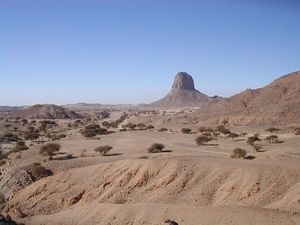
وفقًا لمصادر تاريخية وأثرية، تم الاتفاق على احتلال سرر لجميع مناطق السنغال (بما في ذلك منطقة سنگامبيا). هم من بين أقدم سكان منطقة سنگامبيا. مثل الثقافات الأخرى، لدى السرريين أيضًا ثقافة تسمية الأشياء التي قاموا بإنشائها من فراغ ، والتي تمتد إلى أسماء الأماكن. لا تزال العديد من الأماكن في سنگامبيا، مثل Diamniadio و Diokoul وما إلى ذلك ، تحمل أسماء سرر الخاصة بهم.
تمت دراسة وتوثيق عصور ما قبل التاريخ والتاريخ القديم لسرر على نطاق واسع على مر السنين. يأتي الكثير من البيانات من الاكتشافات الأثرية والتقاليد المتجذرة في ديانة سرر.
تم العثور على العديد من الآثار المتعلقة بعصور ما قبل التاريخ والتاريخ القديم في بلدان سرر. يقدم معظمهم معلومات عن أصول عائلات سرر والقرى وممالك سرر. يتميز البعض بالذهب والفضة والمعادن. كما تم اكتشاف النقوش المگاليثية المنحوتة والمنصوبة في هياكل دائرية
ممالك السرر
المجتمع
المهن
The Serers practice trade, agriculture, fishing, boat building and animal husbandry. Traditionally the Serer people have been farmers and landowners.[24] Although they practice animal husbandry, they are generally less known for that, as in the past, Serer nobles entrusted their herds to the pastoralist Fulas, even today.[25] However, they are known for their mixed-farming.[26] Trade is also a recent phenomenon among some Serers. For the Serers, the soil (where their ancestors lay in rest) is very important to them and they guard it with jealousy. They have a legal framework governing every aspect of life even land law with strict guidelines. Apart from agriculture (and other forms of production or occupation such as animal husbandry, fishing especially among the Serer-Niominka, boat building, etc.), some occupations especially trade they viewed as vulgar, common and ignoble. Hence in the colonial era, especially among the Serer nobles, they would hire others to do the trading on their behalf (e.g. Moors) acting as their middlemen.[27]
التراتب الاجتماعي
The Serer ethnic group is rather diverse, and as Martin A. Klein notes, the institution of slavery did not exist among the Serer-Noon and N'Dieghem.[28]
الثقافة
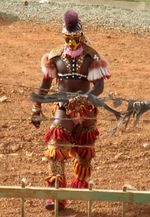
The Serer's favourite food is called Chere (or chereh) in the Serer language (pounded coos). They control all the phases of this dish from production to preparation. Other ethnic groups (or Serers), tend to buy it from Serer women market traders or contract it out to them especially if they are holding major ceremonial events. Chere is very versatile and can be eaten with fermented milk or cream and sugar as a breakfast cereal or prepared just as a standard couscous. The Serer traditional attire is called Serr. It is normally woven by Serer men and believed to bring good luck among those who wear it. Marriages are usually arranged. In the event of the death of an elder, the sacred "Gamba" (a big calabash with a small hollow-out) is beaten followed by the usual funeral regalia to send them off to the next life.[29]
المصارعة والرياضة
الموسيقى
Ali Colleen Neff[30]
لغات السرر
| لغات تشانگين ولغة السرر | % Similarity with Serer-Sine | % Similarity with Noon | % Similarity with Saafi | % Similarity with Ndut | % Similarity with Palor | % Similarity with Lehar (Laalaa ) | Areas they are predominantly found | Estimated population |
|---|---|---|---|---|---|---|---|---|
| Lehar language (Laalaa) | 22 | 84 | 74 | 68 | 68 | N/A | West central, north of Thies, Pambal area, Mbaraglov, Dougnan; Tambacounda area. Also found in the Gambia | 12,000 (Senegal figures only) (2007) |
| Ndut language | 22 | 68 | 68 | N/A | 84 | 68 | West central, northwest of Thiès | 38,600 (Senegal figures only (2007) |
| Noon language | 22 | N/A | 74 | 68 | 68 | 84 | Thiès area. | 32,900 (Senegal figures only (2007) |
| Palor language | 22 | 68 | 74 | 84 | N/A | 68 | West central, west southwest of Thiès | 10,700 (Senegal figures only (2007) |
| Saafi language | 22 | 74 | N/A | 68 | 74 | 74 | Triangle southwest of and near Thiès (between Diamniadio, Popenguine, and Thiès) | 114,000 (Senegal figures only (2007) |
| Serer-Sine language (not a Cangin language) | N/A | 22 | 22 | 22 | 22 | 22 | West central; Sine and Saloum River valleys. Also in the Gambia and small number in Mauritania | 1,154,760 (Senegal – 2006 figures); 31,900 (the Gambia – 2006 figures) and 3,500 (Mauritania 2006 figures)[31] |
الألقاب الأبوية للعائلات
| بعض ألقاب العائلات السررية الشائعة |
|---|
الاحتفالات المعاصرة
Some notable Gambian Serers include Isatou Njie-Saidy, Vice President of the Gambia since 20 March 1997, and the late Senegambian historian, politician and advocate for Gambia's independence during the colonial era – Alhaji Alieu Ebrima Cham Joof. In Senegal they include Léopold Sédar Senghor and Abdou Diouf (first and second President of Senegal respectively), Pascal Ndione, and Marième Faye Sall – current First Lady of Senegal (as of 2020) and wife of President Macky Sall.[32]
انظر أيضاً
|
|
|
|
أعلام السرر
- Léopold Sedar Senghor, first president of Senegal from 1960 to 1980
- Valdiodio N'diaye, Senegalese politician and former Mayor of Kaolack
- Abdou Diouf, second president of Senegal and former secretary general of Organisation Internationale de la Francophonie
- Ngalandou Diouf, was the first African elected since the beginning of colonization
- Fatou Diome, Senegalese author
- Safi Faye, Senegalese film director and ethnologist
- Laïty Kama, Senegalese Lawyer and the first president of the International Criminal Tribunal for Rwanda
- Issa Laye Thiaw, Senegalese historian and theologian
- Alioune Sarr, Senegalese historian and politician
- Isatou Njie-Saidy, former Vice-president of Gambia
- Alieu Ebrima Cham Joof, Gambian historian
- Boucar Diouf, Senegalese humorist
- Yandé Codou Sène, Senegalese griot and musician
- Youssou Ndour, Senegalese musician
- Mame Biram Diouf, Senegalese footballer
- Sadio Mané, Senegalese footballer
- Robert Diouf, Senegalese wrestler
الهامش
- ^ أ ب Agence Nationale de Statistique et de la Démographie. Estimated figures for 2007 in Senegal alone
- ^ أ ب National Population Commission Secretariat (30 April 2005). "2013 Population and Housing Census: Spatial Distribution" (PDF). Gambia Bureau of Statistics. The Republic of The Gambia. Archived (PDF) from the original on 3 January 2018. Retrieved 29 December 2017.
- ^ Claire L. Adida; David D. Laitin; Marie-Anne Valfort (2016). Why Muslim Integration Fails in Christian-Heritage Societies. Harvard University Press. pp. 33–34. ISBN 978-0-674-50492-9.
- ^ "Charisma and Ethnicity in Political Context: A Case Study in the Establishment of a Senegalese Religious Clientele", Leonardo A. Villalón, Journal of the International African Institute, Vol. 63, No. 1 (1993), p. 95, Cambridge University Press on behalf of the International African Institute
- ^ Villalón, Leonardo A., Islamic Society and State Power in Senegal: Disciples and Citizens in Fatick, p. 62, Cambridge University Press (2006), ISBN 9780521032322
- ^ Senegal, CIA Factsheet
- ^ [1] Ethnologue.com
- ^ خطأ استشهاد: وسم
<ref>غير صحيح؛ لا نص تم توفيره للمراجع المسماةGalvan - ^ أ ب Elizabeth Berg; Ruth Wan; Ruth Lau (2009). Senegal. Marshall Cavendish. p. 63. ISBN 978-0-7614-4481-7.
- ^ Leonardo A. Villalón (2006). Islamic Society and State Power in Senegal: Disciples and Citizens in Fatick. Cambridge University Press. pp. 54–55. ISBN 978-0-521-03232-2., Quote: "Serer oral tradition recounts the group's origins in the Senegal River valley, where it was part of, or closely related to, the same group as the ancestors of today's Tukulor."
- ^ Natural Resources Research, UNESCO, Natural resources research, Volume 16, Unesco (1979), p. 265
- ^ أ ب James Stuart Olson (1996). The Peoples of Africa: An Ethnohistorical Dictionary. Greenwood. p. 516. ISBN 978-0-313-27918-8.
- ^ أ ب ت Pierret, Paul, "Dictionnaire d'archéologie égyptienne", Imprimerie nationale 1875, p. 198-199 [in] Diop, Cheikh Anta, "Precolonial Black Africa", (trans: Harold Salemson), Chicago Review Press, 1988, p. 65
- ^ خطأ استشهاد: وسم
<ref>غير صحيح؛ لا نص تم توفيره للمراجع المسماةMartin A. Klein 1968 - ^ Leonardo A. Villalón (2006). Islamic Society and State Power in Senegal: Disciples and Citizens in Fatick. Cambridge University Press. pp. 71–74. ISBN 978-0-521-03232-2.
- ^ خطأ استشهاد: وسم
<ref>غير صحيح؛ لا نص تم توفيره للمراجع المسماةResnick2013p165 - ^ Martin A. Klein (1968). Islam and Imperialism in Senegal: Sine-Saloum, 1847–1914. Stanford University Press. pp. 7–11. ISBN 978-0-8047-0621-6.
- ^ خطأ استشهاد: وسم
<ref>غير صحيح؛ لا نص تم توفيره للمراجع المسماةtamari221 - ^ Patience Sonko-Godwin. Ethnic Groups of The Senegambia Region. A Brief History. p32. Sunrise Publishers Ltd. Third Edition, 2003. قالب:Asin
- ^ Ethnologue.com. Languages of Senegal. 2007 figures
- ^ African Census Analysis Project (ACAP). University of Pennsylvania. Ethnic Diversity and Assimilation in Senegal: Evidence from the 1988 Census by Pierre Ngom, Aliou Gaye and Ibrahima Sarr. 2000
- ^ "La Religiosité des Sereer, avant et pendant leur Islamisation". Éthiopiques, No: 54, Revue Semestrielle de Culture Négro-Africaine. Nouvelle Série, Volume 7, 2e Semestre 1991. By Issa Laye Thiaw
- ^ أ ب ت Gravrand, Henry: La Civilisation Sereer - Pangool. Les Nouvelles Éditions Africaines du Senegal. 1990. pp, 9, 20 & 77. ISBN 2-7236-1055-1.
من أعلى لأسفل: الصورة الأولى دوائر الأحجار السنگامبية (ميجليث) تمتد من السنغال وبطول گامبيا ويصفها اليونسكو كالتالي:
- "أكبر تجمع للدوائر الحجرية في أي مكان في العالم."
- Becker, Charles, Vestiges historiques, témoins matériels du passé dans les pays sereer, CNRS-ORSTOM, 1993 [2]
- ^ Godfrey Mwakikagile. The Gambia and Its People: Ethnic Identities and Cultural Integration in Africa, p11. ISBN 9987-16-023-9
- ^ Encyclopædia Britannica, inc. The New Encyclopædia Britannica, Volume 29, p-p 855-6 and 912. Encyclopædia Britannica, 2003. ISBN 0-85229-961-3
- ^ Tiyambe Zeleza. A Modern Economic History of Africa: The nineteenth century, p110. East African Publishers, 1997. ISBN 9966-46-025-X
- ^ Dennis Galvan. Market Liberalization as a Catalyst for Ethnic Conflict. Department of Political Science & International Studies Program. The University of Oregon. pp 9–10
- ^ Klein (1968), p. 165
- ^ Godfrey Mwakikagile. The Gambia and Its People: Ethnic Identities and Cultural Integration in Africa, p141. ISBN 9987-16-023-9
- ^ خطأ استشهاد: وسم
<ref>غير صحيح؛ لا نص تم توفيره للمراجع المسماةAli Colleen Neff 2010 - ^ NB: 2006 Figures are taken in order to compare the population of the Serer in the respective countries.
- ^ Jeune Afrique, Sénégal : Marième Faye Sall, nouvelle première dame, 26 March 2012 by Rémi Carayol [3] (retrieved on 8 February 2020)
ببليوگرافيا
- Diouf, Mamadou & Leichtman, Mara, New perspectives on Islam in Senegal: conversion, migration, wealth, power, and femininity. Published by: Palgrave Macmillan. 2009. the University of Michigan. ISBN 0-230-60648-2
- Diouf, Mamadou, History of Senegal: Islamo-Wolof model and its outskirts. Maisonneuve & Larose. 2001. ISBN 2-7068-1503-5
- Gamble, David P., & Salmon, Linda K. (with Alhaji Hassan Njie), Gambian Studies No. 17. People of the Gambia. I. The Wolof with notes on the Serer and Lebou San Francisco 1985.
- Niang, Mor Sadio, "CEREMONIES ET FÊTES TRADITIONNELLES", IFAN, [in] Éthiopiques, numéro 31 révue socialiste de culture négro-africaine 3e trimestre (1982)
- Taal, Ebou Momar, Senegambian Ethnic Groups: Common Origins and Cultural Affinities Factors and Forces of National Unity, Peace and Stability. 2010
- Diouf, Niokhobaye. "Chronique du royaume du Sine." Suivie de notes sur les traditions orales et les sources écrites concernant le royaume du Sine par Charles Becker et Victor Martin. (1972). Bulletin de l'Ifan, Tome 34, Série B, n° 4, (1972)
- Berg, Elizabeth L., & Wan, Ruth, "Senegal". Marshall Cavendish. 2009.
- Mahoney, Florence, Stories of Senegambia. Publisher by Government Printer, 1982
- Daggs, Elisa . All Africa: All its political entities of independent or other status. Hasting House, 1970. ISBN 0-8038-0336-2
- Department of Arts of Africa, Oceania, and the Americas, The Metropolitan Museum of Art. Hilburn Timeline of Art History. The Fulani/Fulbe People.
- Schuh, Russell G., The Use and Misuse of language in the study of African history. 1997
- Burke, Andrew & Else, David, The Gambia & Senegal, 2nd edition – September 2002. Published by Lonely Planet Publications Pty Ltd, page 13
- Nanjira, Daniel Don, African Foreign Policy and Diplomacy: From Antiquity to the 21st Century. Page 91–92. Published by ABC-CLIO. 2010. ISBN 0-313-37982-3
- Lombard, Maurice, The golden age of Islam. Page 84. Markus Wiener Publishers. 2003. ISBN 1-55876-322-8,
- Oliver, Roland Anthony, & Fage, J. D., Journal of African History. Volume 10. Published by: Cambridge University Press. 1969
- The African archaeological review, Volumes 17–18. Published by: Plenum Press, 2000
- Ajayi, J. F. Ade & Crowder, Michael, History of West Africa, Volume 1. Published by: Longman, 1985. ISBN 0-582-64683-9
- Peter Malcolm Holt, The Indian Sub-continent, south-East Asia, Africa and the Muslim West. Volume 2, Part 1. Published by: Cambridge University Press. 1977. ISBN 0-521-29137-2
- Page, Willie F., Encyclopedia of African history and culture: African kingdoms (500 to 1500). Volume 2. Published by: Facts on File. 2001. ISBN 0-8160-4472-4
- Ham, Anthony, West Africa. Published by: Lonely Planet. 2009. ISBN 1-74104-821-4, ISBN 978-1-74104-821-6
- Mwakikagile, Godfrey, Ethnic Diversity and Integration in the Gambia. Page 224
- Richard, François G., "Recharting Atlantic encounters. Object trajectories and histories of value in the Siin (Senegal) and Senegambia". Archaeological Dialogues 17 (1) 1–27. Cambridge University Press 2010
- Diop, Samba, The Wolof Epic: From Spoken Word to Written Text. "The Epic of Ndiadiane Ndiaye"
- Two studies on ethnic group relations in Africa – Senegal, The United Republic of Tanzania. Pages 14–15. UNESCO. 1974
- Galvan, Dennis Charles, The State Must Be Our Master of Fire: How Peasants Craft Culturally Sustainable Development in Senegal. Berkeley, University of California Press, 2004
- Klein, Martin A., Islam and Imperialism in Senegal Sine-Saloum, 1847–1914, Edinburgh University Press (1968)
- Colvin, Lucie Gallistel, Historical Dictionary of Senegal. Scarecrow Press/ Metuchen. NJ – London (1981) ISBN 0-8108-1885-X
- Sonko Godwin, Patience, Leaders of Senegambia Region, Reactions To European Infiltration 19th–20th Century. Sunrise Publishers Ltd – The Gambia (1995) ISBN 9983-86-002-3
- Sonko Godwin, Patience, Ethnic Groups of The Senegambia Region, A Brief History. p. 32, Third Edition. Sunrise Publishers Ltd – The Gambia (2003). قالب:Asin
- Clark, Andrew F., & Philips, Lucie Colvin, Historical Dictionary of Senegal. Second Edition (1994)
- Portions of this article were translated from the French language Wikipedia article fr:Sérères, 2008-07-08 and August 2011.
وصلات خارجية
- Short description is different from Wikidata
- "Related ethnic groups" needing confirmation
- Articles using infobox ethnic group with image parameters
- مقالات ذات عبارات بحاجة لمصادر
- Articles with hatnote templates targeting a nonexistent page
- Pages with empty portal template
- سيرير (شعب)
- جماعات عرقية دينية في أفريقيا
- جماعات عرقية في السنغال
- جماعات عرقية في گامبيا
- جماعات عرقية في موريتانيا


